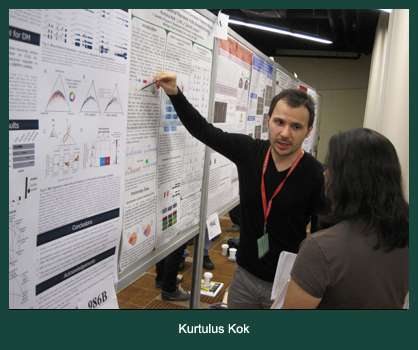Batting practice in the genome

In the biochemical game of genetics, it was thought that the proteins controlling gene regulation in animals were either spectators or players.
But in research appearing in the current issue of eLife, Michigan State University researchers found that spectator proteins are actually practicing up for the big game. They discovered that the proteins are biochemically interacting with thousands of regions of the genome to change the structure of chromosomal material, although only few of them actually are able to change gene expression.
"The previous thinking was that these proteins were wasting time and energy, like office workers spending time on Facebook," said David Arnosti, biochemistry professor and director of the Gene Expression in Development and Disease Initiative. "But they're actually more like baseball players taking batting practice, warming up for the real thing - the actual gene switch."
This discovery, made while examining gene switches in the Drosophila, or fruit fly, could lead to a better understanding of the DNA/protein complexes that control expression of genes and points to ways that these elements may evolve. This could have major ramifications for human health, with potential application in the treatment of diseases such as Alzheimer's and various cancers.
"Understanding the control switches is important in understanding how humans work, and understanding our vulnerability to disease," Arnosti said.
In Arnosti's lab, graduate students Kurtulus Kok and Li Li developed a new method to directly trace the biochemical impact of a regulatory protein in the embryo. In examining this activity, the researchers made new insights suggesting that previous genome-wide studies may improperly mistake such "batting practice" for actual regulatory elements, a difference that is important for understanding how mutations in the genome may affect gene expression.
But practice also may serve a long-term role.
"This process provides an evolutionary opportunity, where 'practice' elements may quickly change to the real thing, allowing genetic networks to be readily rewired under the selection of evolutionary pressure," Arnosti said. "This changes in a major way evaluations of active and pseudo gene switches - the current approach is too simplistic."
As for the fruit flies, their use as a model system is a matter of convenience. Fruit flies have an overall genome that is typical of many animals. They are inexpensive, easy to manipulate and have short life cycles.
"Fruit flies have the same molecular circuitry as humans, going back to ancient mechanisms more than 500 million years old," Arnosti said.
More information: eLife, elifesciences.org/content/4/e06394
Journal information: eLife
Provided by Michigan State University




















